Video Marketing Guide: Learn Video Marketing Strategy & Tips
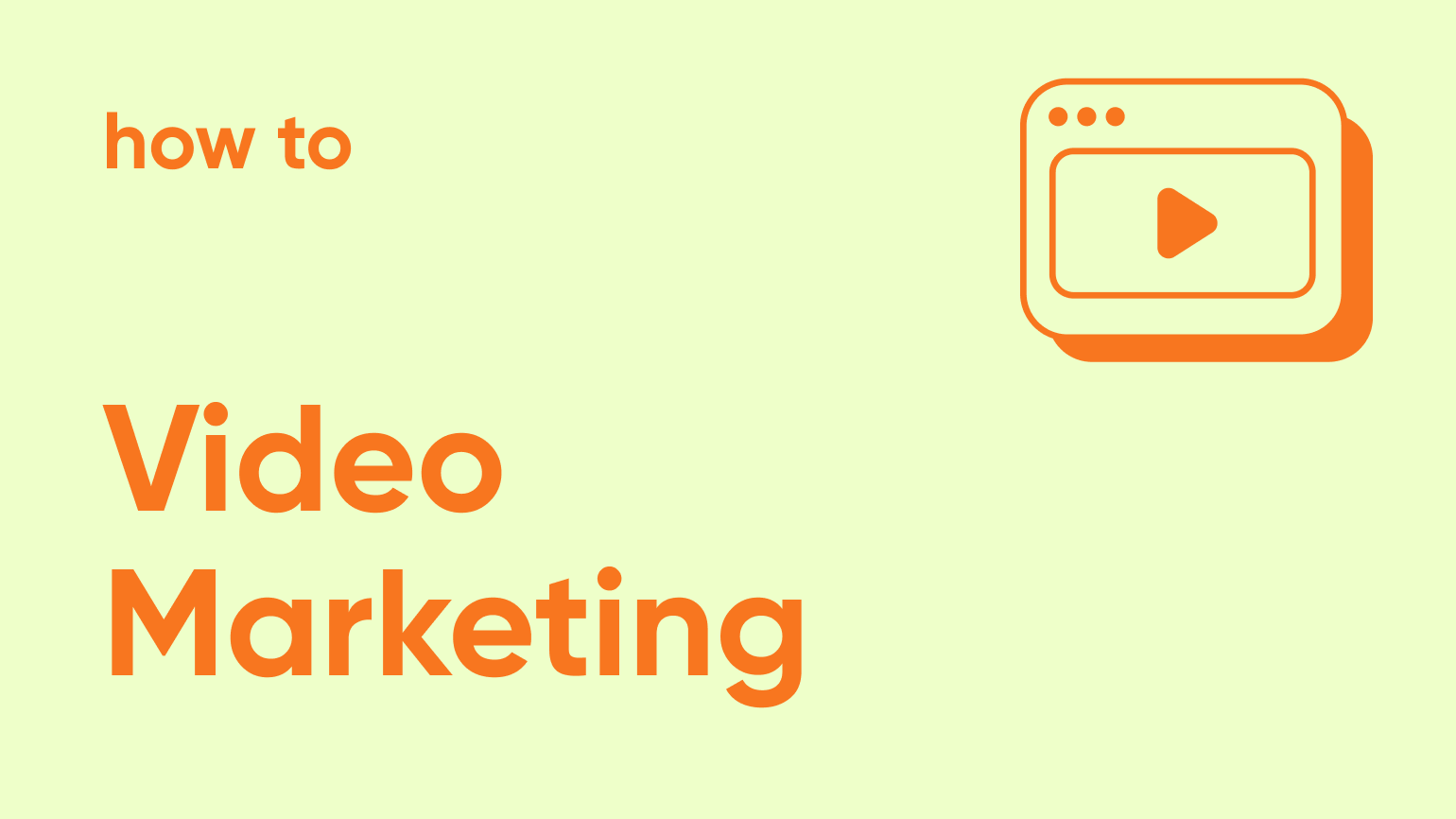
Video marketing isn't an exclusive club for giant corporations with endless budgets. Businesses of all sizes are now seizing the power of video to connect with their audiences.
Think about it; more than 500 hours of video content is uploaded to YouTube every minute. That's more content than anyone could digest in several lifetimes. All things considered, this potential for exposure is no longer just a big brand luxury. It's becoming a necessity for businesses of all sizes to hold a stake in the digital world.
This blog acts as a guide through the promising world of video marketing that is no longer confined to the high walls of corporate giants.
What is Video Marketing
Video marketing is simply using videos to promote and market your product or service. It's about grabbing attention and engaging your audience in a way that's both visual and informative.
Imagine a tech company with an innovative new product. They can create a short, engaging explainer video demonstrating how their software solves complex problems. This video can be shared across social media platforms, embedded in emails, and displayed on their website. That's video marketing. Using video to promote your business.


Try the Best Video Marketing Tool
Start for free up to 30 registrants. No credit card needed.
Start for freeWhy Video Marketing Matters for Businesses
The Affordability of Video Marketing
With the number of available free online tools and platforms, video marketing has become more affordable than ever. It's no longer exclusive to companies with extravagant marketing budgets.
Gone are the days when creating a video meant hiring a professional videographer and spending thousands on high-end equipment. In its place, a simple smartphone and some creativity can go a long way.
Affordable, easy-to-use recording, editing, and distribution software is widely available, making it simpler for companies to produce compelling content with minimal cost and effort. They also allow for quick and easy changes, making it possible to adapt the content to evolving business needs and trends. This affordability allows businesses to compete in the video marketing space, reaching more audiences and boosting overall visibility.
Some of our favorite (and cheapest) video marketing tools:
- Contrast: webinars
- Descript: video editing
- Tella: screen recording
- Embed: video embed
- Talk: video conferencing
The Impact of Video Marketing on Business Growth
Video marketing can greatly impact the growth of businesses, even small ones. It has become a vital tool in establishing an online presence and driving customer engagement.
Customer engagement increases when a video is involved. By adding videos into their marketing strategy, businesses can enhance their interaction with potential customers.
Videos can also help improve SEO. Search engines favor websites with video content, leading to higher rankings in search results. This can improve a business's visibility among consumers and potentially improve sales figures.
Video SEO is also a great strategy to outrank competitors that might have bigger budgets, older domains, or more resources.
Not only that, but videos are shareable. They can spread across social media platforms quickly and drive more traffic to your website. If a video is enjoyable or informative, people are likely to share it, putting your brand in front of a larger audience without any additional effort or cost on your part.
In a digital world with short attention spans, videos grab attention quickly. They share your brand's message clearly. Videos are affordable and help grow your business. Video marketing is a tool businesses should use.
Types of Video Marketing Content
In digital marketing, using different types of video content can spread your message further. Here are some key types that work well for businesses.
Explainer Videos
These videos explain your company’s message in a simple way. They break down complex ideas into easy pieces. Explainer videos show how your product solves a problem. They quickly capture interest and help potential customers understand.
Product Demos
Product demos showcase how your products work and highlight their unique features. They offer a real-world perspective, helping potential customers see the benefits firsthand. These videos build trust and assist in making informed purchasing decisions, effectively boosting sales.
Customer Testimonials
Testimonials feature happy customers sharing their stories. They provide real and relatable content. This builds trust and shows the value of your product. It can be a big influence on new buyers.
Behind-the-Scenes Videos
These videos show your company culture and operations. They humanize your brand. This transparency builds trust and loyalty. It shows the team and processes behind your success.
Educational or How-To Videos
These videos show your brand as an expert. They provide helpful insights or instructions. This drives engagement and builds your reputation as a trusted partner.
Webinars
Webinars are a popular video marketing tactic. Webinars allow for interaction and deep discussions.
Companies across the world use Contrast to host webinars that attendees love.
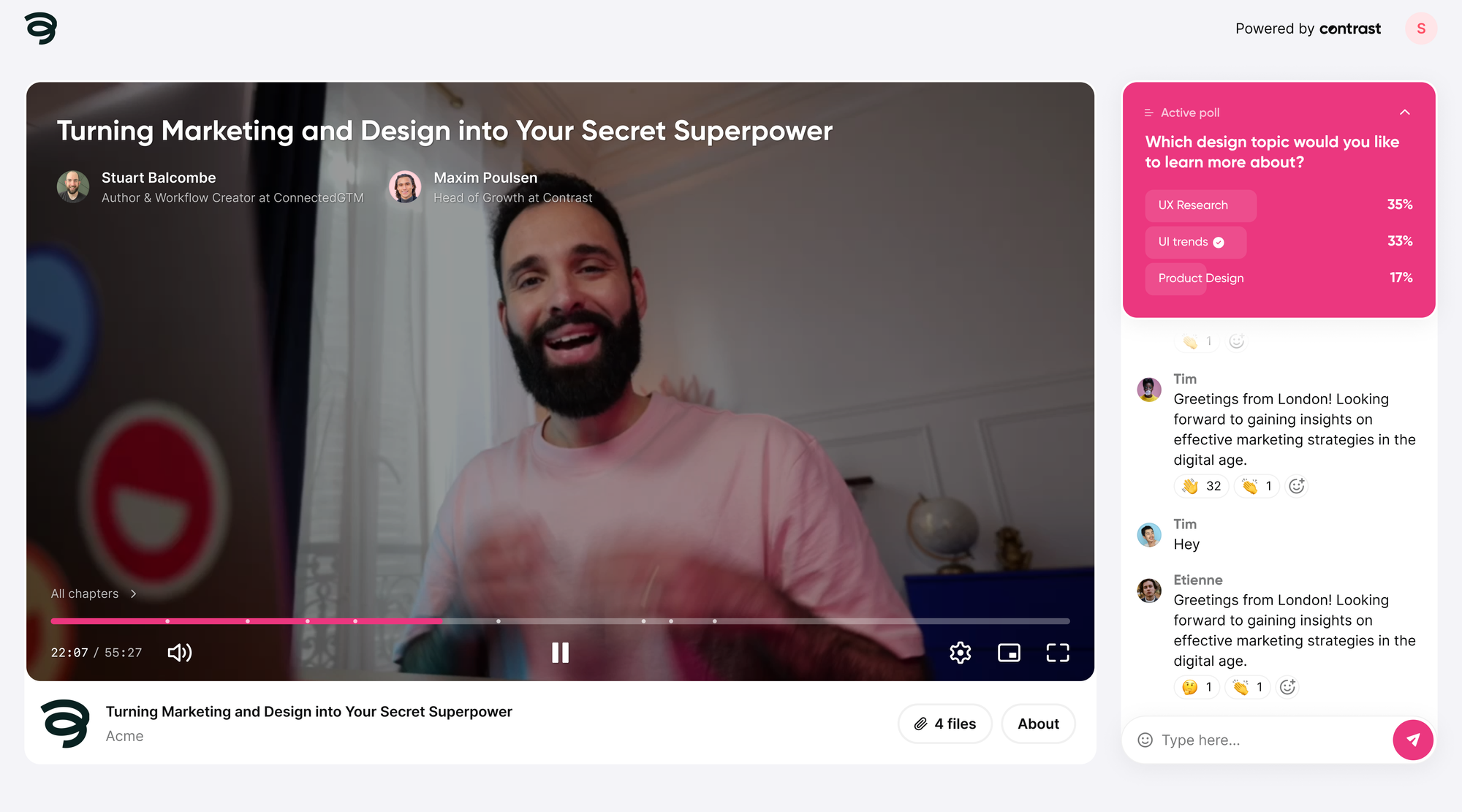
User-Generated Content
This content uses your customers' creativity. It encourages them to share their experiences with your products. This broadens your reach and boosts community engagement.
How to Build a Video Marketing Strategy
Now let's focus on how to build a video marketing strategy. First, you'll identify your video marketing goals. Next, choose video content that matches your brand and audience. Finally, you'll create engaging videos that capture attention.
Step 1: Define Your Video Marketing Goals
Taking the first step into the realm of video marketing starts with crystal clear goal setting. Are you aiming for increased brand awareness or focusing on boosting your lead generation? Perhaps your aim is user education about a particular new product or service. Your goals will guide your video marketing tactics, channeling your efforts and resources to achieve the desired outcomes.
These goals must be measurable and tied to metrics that provide insight into your video marketing performance. Without measurable goals, your strategy could drift off course like a boat without a compass. Measurable goals offer meaningful targets as well as indicators of when adjustments are necessary to stay on track.
SMART goals are a powerful framework for setting clear, achievable objectives. The acronym SMART stands for Specific, Measurable, Achievable, Relevant, and Time-bound. Each element serves as a guideline to ensure your goals are well-defined and within reach.
- Specific means your goal should be clear and precise, so you know exactly what you're aiming for. Instead of saying, "I want a lot of registrants for my webinar" specify the goal to something like, "I want 300 people to register to my webinar"
- Measurable criteria allow you to track your progress. For the webinar goal, it's easy to measure the number of registrants in your webinar dashboard.
- Achievable means setting realistic goals that you're capable of accomplishing. It's about finding the balance between challenging yourself and not setting yourself up for failure.
- Relevant ensures that your goal matters to you and aligns with your other business objectives. It's about making sure the goal is worth your time and effort.
- Time-bound adds a deadline, creating urgency and helping you focus. For example, aiming to achieve those 300 registrants for your next webinar in 2 weeks.
Step 2: Choose the Right Type of Video Content
The second stage of your journey urges you to consider video content types that will best match your identified goals. If your intention is to build brand awareness, perhaps an entertaining viral-style video would work well. To nurture leads, consider informative webinars or product demonstrations. When educating users is the primary goal, tutorial or how-to videos might be the gold standard.
Each video category has its unique strengths and appeal, which may vary across different audience segments. It is crucial to match your video content to not only your goals but also your target audience's preferences and behaviors.


Try the Best Video Marketing Tool
Start for free up to 30 registrants. No credit card needed.
Start for freeStep 3: Create Engaging Video Content
Your content strategy will be significantly amplified by developing engaging video content that captures your audience's attention. Engaging content is more likely to be viewed, shared, and sometimes even viral—increasing your brand's exposure immeasurably.
Focus on shaping content that resonates with your target audience, appealing to their interests, values and addressing their pain points. Videos that offer solutions to problems will naturally draw an audience. Integrating storytelling into your videos can also enhance their appeal, creating an emotional connection with viewers.
Take advantage of tools and techniques that enhance engagement. Call to actions, for example, can guide viewers to a follow-up step, while captions can make your video content accessible even when the sound is off.
Using interactive tools is a great way to create more engaging video content: the best webinars are those where you feel like you're having a conversation with the hosts. Running Q&A sessions, polls, or interacting in the chat are great ways to make your videos more engaging.
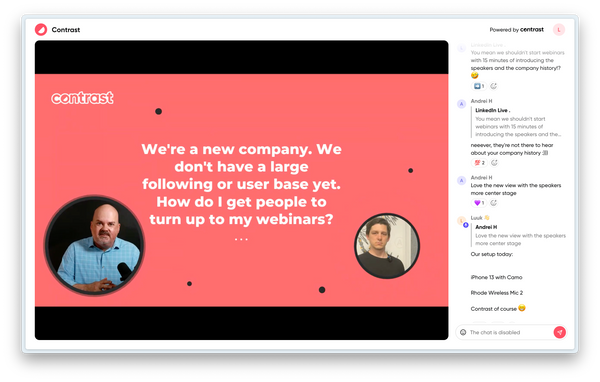
Video marketing is not a maze that only big brands can navigate. With clear goals, the right content, and a focus on engagement, businesses of all sizes can reap tremendous benefits from an expertly executed video marketing strategy.
Boosting Brand Awareness with Video Marketing
Videos are powerful tools for building a strong online presence. Well-made videos help businesses show their values and unique features. They engage audiences with a mix of sights and sounds.
Good visuals spread brand messages quickly. They reach more people and different customer groups. According to HubSpot marketing statistics, 89% of people say that they’ve been convinced to buy a product or service by watching a brand’s video. (Wyzowl, 2023)
Our data shows that customers that run branded webinars have higher registration rates, attendance rates, and end up selling more & better than customers that don't brand their webinars.
💡
Many B2B businesses suffer from a lack of fun. Think of how you can make your videos and virtual events more fun.
Driving Sales with Video Marketing
The main goal of marketing is to boost sales. Video marketing is great for this. Well-designed videos can increase conversion rates. But to succeed, the content must match what customers need and like.
Product demos, webinars, explainer videos, customer testimonials, and even simple promotional clips can play significant roles in nudging consumer behaviors. They offer a visually rich, informative, and persuasive insight into a product or service that other content types fail to replicate.
All of these types of video marketing fit into a funnel, slowly driving your leads from simply aware of your brand, to being fully-fledged customers.
Remember, the success of video marketing strategy in driving sales is heavily dependent on understanding and catering to the target audience's behaviors, expectations, and pains. Therefore, any video marketing strategy must place the customer at its core.
Keeping Up with Video Marketing Trends
- Discover how short-form video content is grabbing attention
- Understand the crucial role of Video SEO in marketing
The Rise of Short-Form Video Content
People's attention spans are getting shorter; thus, short-form video has risen to popularity. Considered to be 60 seconds or less, these bite-sized videos are shared on social platforms like Instagram, Twitter, TikTok, and Facebook. The advantage? They're cheaper, quicker to produce, and can reach a broad audience with minimal budget. But what's most important - they engage viewers quickly, providing brands a chance to stand out amidst all the digital clutter.
These snappy, addictive videos are perfect for mobile users, who now make up over half of all worldwide online traffic. Whether it’s a tutorial, a behind-the-scenes glimpse into your business, a customer testimonial, or a simple product demo – short-form videos can powerfully convey your message even in a bite-size format. This trend is here to stay, and marketers should ready themselves to make the most of it.
Using the hub and spoke model popularized by Gary V., create long-form video content (like a webinar) and then turn that main piece of content into different shorter form pieces of content: social posts, clips, blog articles, etc. You can also make it available on-demand to keep driving people to watch that content.
The Importance of Video SEO
Rarely do people see unsearched video content. That's why Video SEO is important. By optimizing your videos for search engines, you're increasing visibility, driving more organic traffic, and boosting engagement. And when the content is engaging, it drives viewers to share, potentially going viral. Overall, Video SEO adds value to your overall SEO strategy - helping your brand to rank higher in both video and web searches.
Keywords play a huge part in SEO. For videos, these aspects are important to optimize - video titles, descriptions, metadata, tags, captions and transcripts. But it goes beyond keywords. Google also considers the overall viewer experience - so factors like click-through-rates, video watch time, user engagement, and social shares also come into play. You can leverage AI for your SEO to help you create optimized content and rank faster.
By understanding and following video marketing trends, businesses of all sizes can tap into the power of video to increase brand visibility, foster engagement, and ultimately, drive growth.
Leveraging Video Marketing Tools for Success
Contrary to common belief, creating effective video content doesn't have to break the bank. There are a lot of DIY tools available that can support businesses in creating engaging and high-quality content. These tools range from video creation and editing tools to video SEO tools, analytics tracking, and more. We'll cover a more detailed list of tools in the next section.
Using these tools and video marketing techniques makes content creation easier and improves video performance. They also give useful insights to refine strategies and better reach your audience.
One thing's for sure: no matter the size of your business - with the right strategies and tools in place, video marketing is not out of reach.
Choosing the Best Video Marketing Tools
In this section, we'll explore how the right tools make video marketing easy - regardless of tech skills. We'll cover how videos can be shared and repurposed on different platforms, and how to track video performance.
Video Creation Tools
Video production used to need special skills and equipment. Now, it's easier than ever. With versatile tools, creating a great story is simple and manageable.
For instance, apps like Biteable and Animaker help professionals create high-quality promotional videos from pre-built templates. With these tools, you won't need an in-depth understanding of video editing – simply choose a template you like and populate it with your content.
For longer form video marketing content like webinars, customer interviews, panel discussions, tools like Contrast are great. You can plan a live stream in just a couple clicks with a built-in registration page.
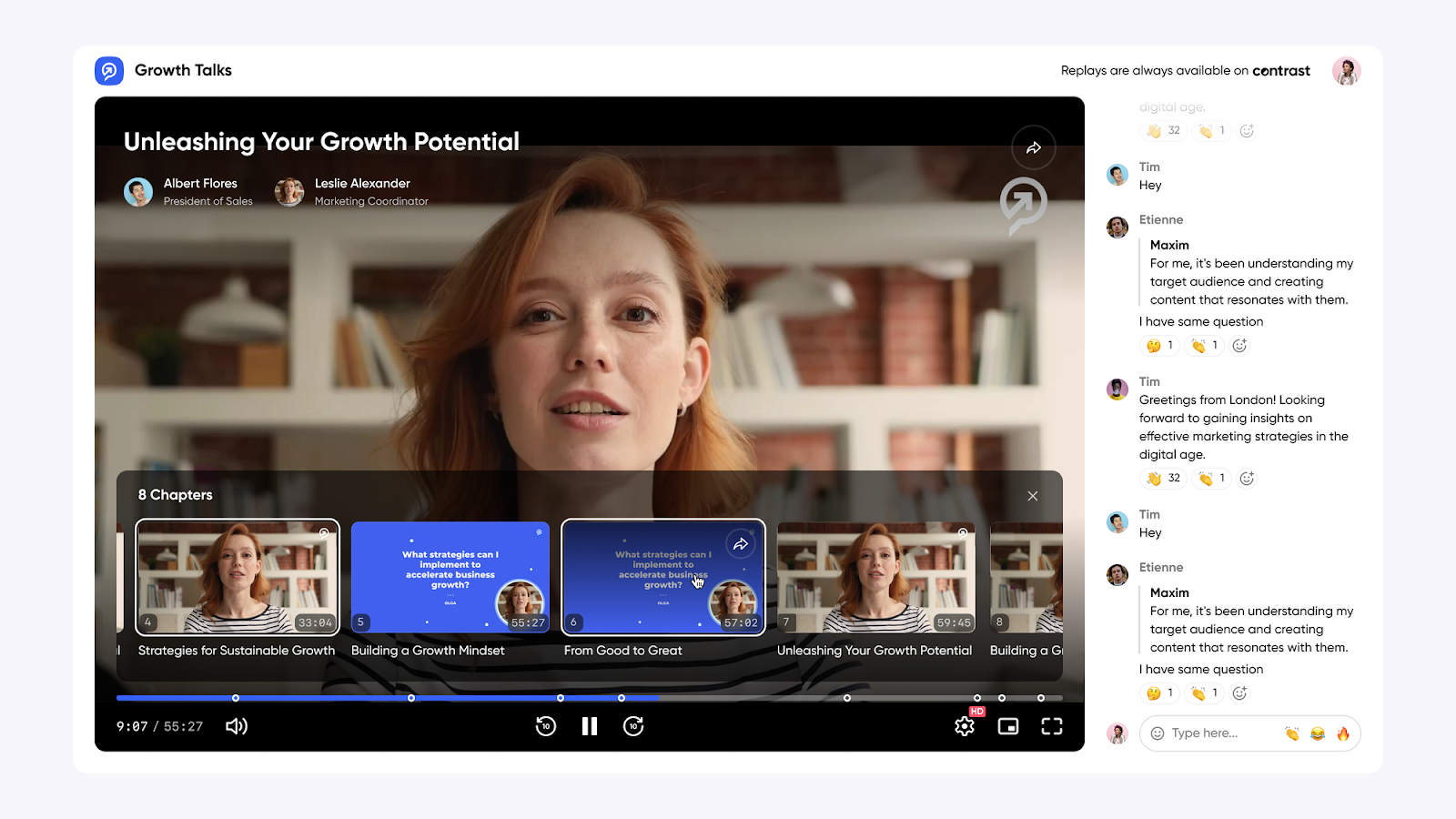
Video Hosting Platforms
Once created, your videos need a home – and not just any home, but one that maximizes visibility and engagement. Fortunately, a plethora of video hosting platforms offers multi-faceted advantages.
Again, consider Contrast, which provides a user-friendly interface to host all of your video content in a Contrast-like experience. This branded experience has no ads, external content, and allows you to provide a high-quality experience to your viewers. You can also require people to register to watch the content, giving you a ton of data on who is consuming your content and how.
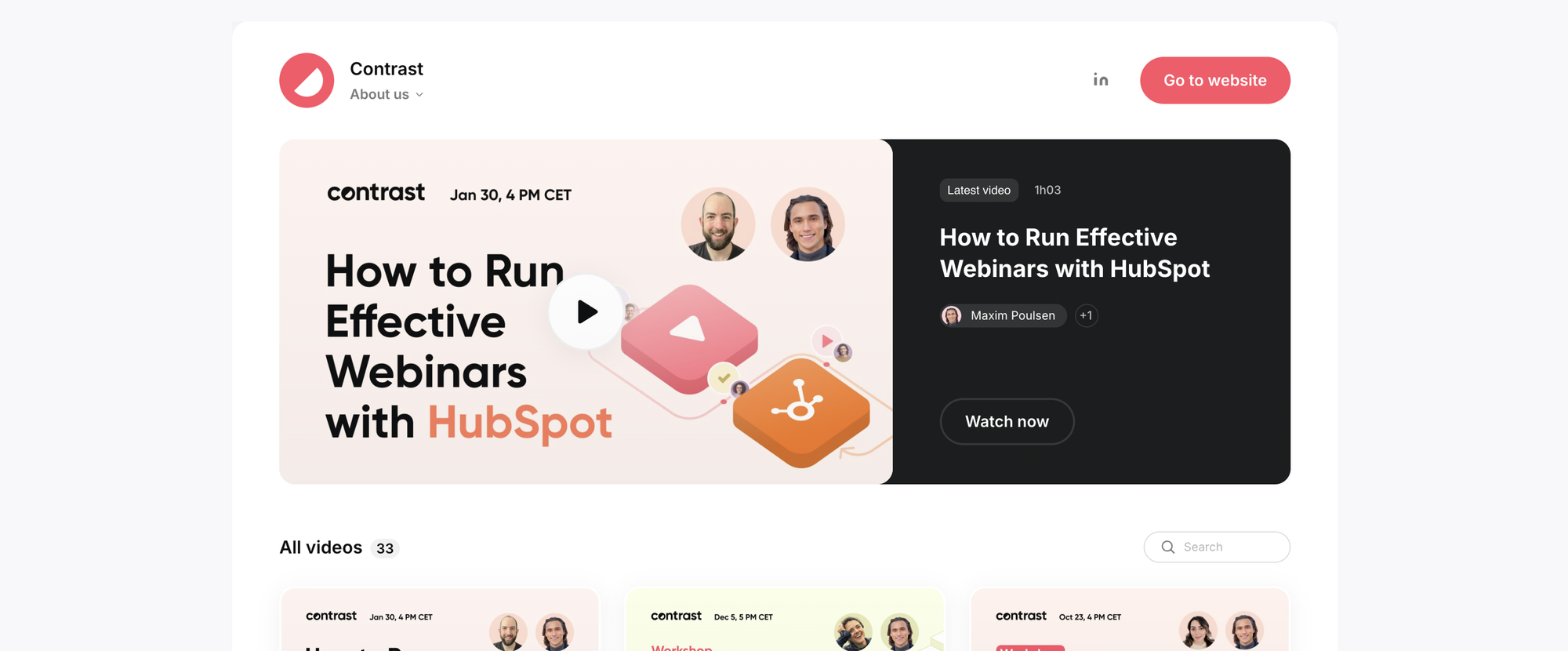
You can also use our free Embed tool to host videos and embed them on your website in a branded player.
Youtube can also give substantial exposure due to its massive user base and effective audience targeting capabilities. LinkedIn is also an option for B2B companies, as they allow targeted video shares within professional networks and can result in excellent viewer interactions.
Video Analytics Tools
Video analytics tools help you understand viewer behavior better. With tools like Contrast, you can host any video and measure video performance. This data helps create strong strategies for improvement.
These tools can track much more than just views. They also capture data on viewer engagement, time watched, re-watches, and even heatmap views demonstrating where attention was most focused during your video. Such insights prove invaluable in tweaking your video strategy to enhance user engagement and conversion rates.
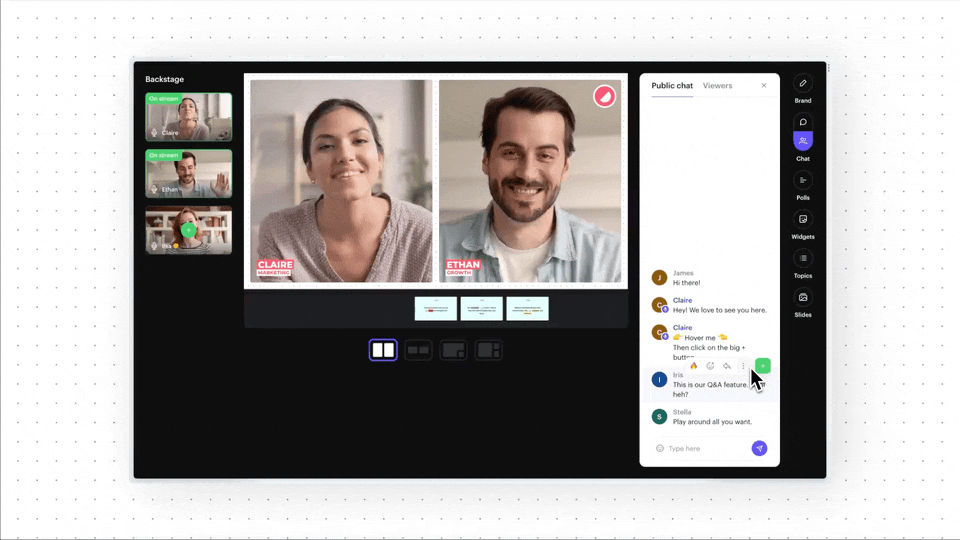
Video Repurposing Tools
Video repurposing tools allow you to maximize the value of your video content by adapting it for different platforms, audiences, or formats. Here are some powerful tools that can help with video repurposing:
Contrast helps you repurpose your video content into different formats: newsletters, social posts, subtitles clips, and help you keep distributing your long-form content.
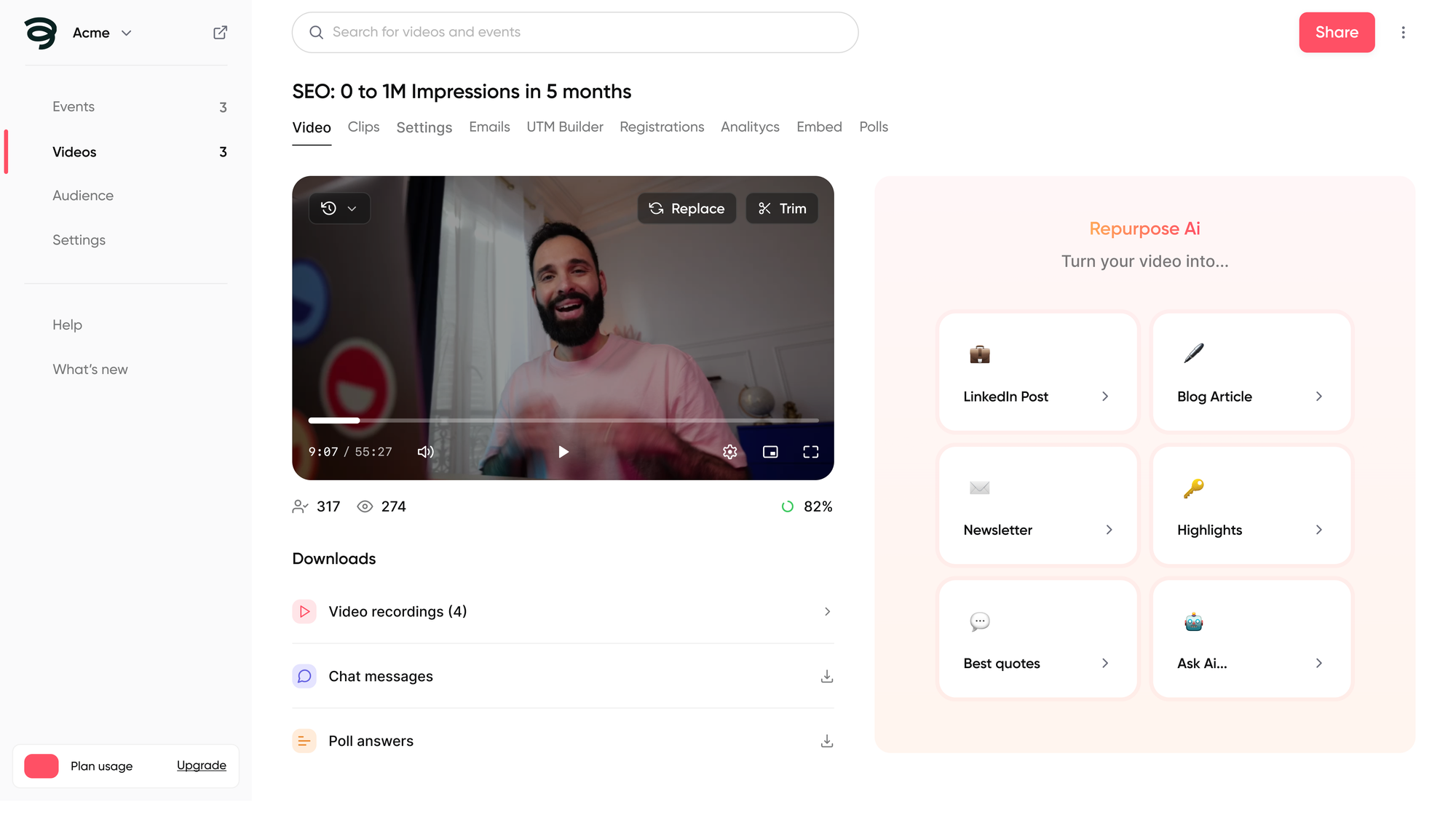
Lumen 5 is an AI-driven tool that helps turn blog posts and articles into engaging videos. It's particularly effective for repurposing written content into video format for social media or content marketing.
Adobe Premiere Pro: A leading video editing software that offers a comprehensive set of features for editing, adjusting, and reformatting videos for various uses. It's ideal for creating different versions of a video for social media, web, or broadcast.
Each tool has its own strengths. They work well for different video projects. You can adapt long videos for social media or turn blog posts into videos. You can also make promo clips from existing footage. There's a tool to make the process easier and boost your content's reach.
Tips and Best Practices for Video Marketing
Staying Authentic and Relatable
In video marketing, being real is key. Audiences want genuine connections with brands. Your videos should feel authentic and relatable. Avoid overly polished content. Share stories and experiences that connect emotionally. Authentic content engages viewers and builds lasting connections.
A big part of why people like the webinars we run at Contrast is because I keep it real with audiences. I'm myself. I don't try to put on an act or make the webinars overly professional. It would come across as inauthentic. Being myself boosts audience engagement.
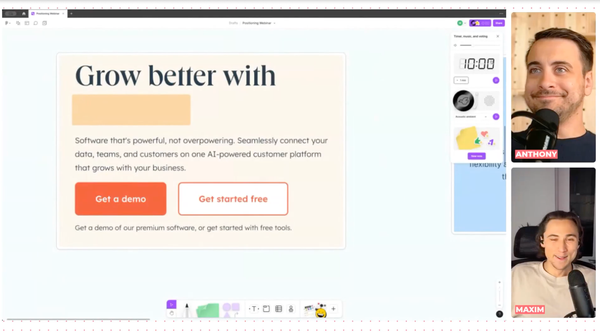
Consistency in Branding and Messaging
Consistency keeps your brand's voice clear. Use the same look and message in all videos. Include brand colors, logos, and fonts for visual harmony. Align your messaging with your brand's values. Keep a coherent narrative in all content.
With Contrast you can keep webinars on brand. You're able to customize colors, layouts, and interactive elements.

Legal Considerations in Video Marketing
Follow legal rules in video marketing. Make sure you're complying with copyright laws and privacy regulations. Get rights for music, images, or clips used. Use consent forms when filming people. Be clear about using user-generated content. Staying informed about legal requirements protects your brand.
Crafting Engaging Stories
Video marketing is all about telling a good story. The human brain is wired for stores. Stories capture attention and make your message memorable. Focus on creating narratives that resonate with your audience. Use relatable characters and situations to draw viewers in. A well-crafted story can turn viewers into loyal fans.
Optimal Video Lengths for Different Platforms
Different platforms have ideal video lengths. Short videos work well on social media, where attention spans are brief. Longer videos are better for webinars and platforms like YouTube, where viewers expect more in-depth content. You can learn more by reading our guide to webinar lengths.
Incorporating Calls-to-Action (CTAs)
CTAs guide viewers on what to do next. They can encourage actions like subscribing, visiting a website, or making a purchase. Different types of CTAs are used across the user journey in video marketing. Buttons are visible and clickable, like a "Secure Your Spot" button on a webinar registration page. Text CTAs use hyperlinked text, like in the caption of your video. Spoken CTAs are probably the most frequently used CTA in video marketing. These are verbal prompts where the speaker in the video instructs the audience to take an action.
Case Study: How Airfocus Used Video to Boost MQLs
Airfocus is a company that makes software for product managers. They improved their webinars by switching from Livestorm to Contrast. Olivia, their Head of Marketing, said they now capture more leads. About 65% of webinar attendees become marketing-qualified leads (MQLs).
The integration with HubSpot helps their sales team follow up in a personal way. They get key facts about who watched the webinars and how engaged they were. This makes the sales process smoother.
Contrast's Repurpose Ai feature turned their webinars into a content machine. They can quickly create blog articles, video clips, and social media posts from webinar content. This saves time and resources.
Using Contrast has boosted engagement and lead generation for airfocus. It also helped them become thought leaders in their industry.
Read more: How Contrast became a content machine for airfocus
Seize the Power of Video Marketing
Video marketing has now become a robust tool accessible to businesses of all sizes. It's no longer the playground for just big brands. The advent of technology and social media integration has leveled the playing field, providing an effective, engaging, and personalized means to reach your target audience.
This is a golden opportunity - an era where video content can gain you traction on social platforms, improve your SEO and ROI, increase brand awareness or credibility, and importantly, drive your customer engagement and conversions.
Here's what to do: start incorporating video marketing into your digital strategy. Try experimenting with different types of video, and understand what resonates with your audience. From a brief explainer video on your homepage to product tutorials or customer testimonials, each has the potential to make a powerful connection with your audience.


Try the Best Video Marketing Tool
Start for free up to 30 registrants. No credit card needed.
Start for free